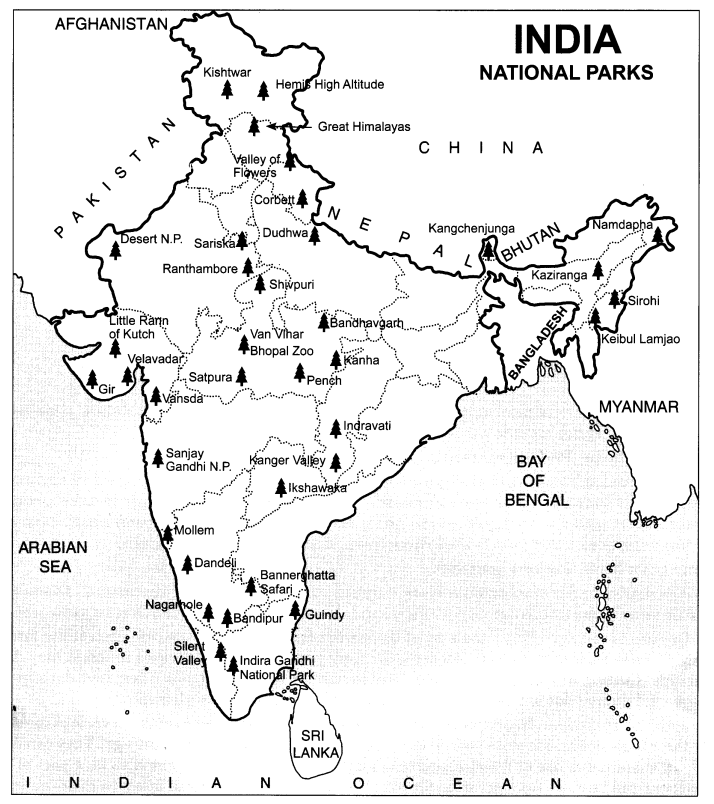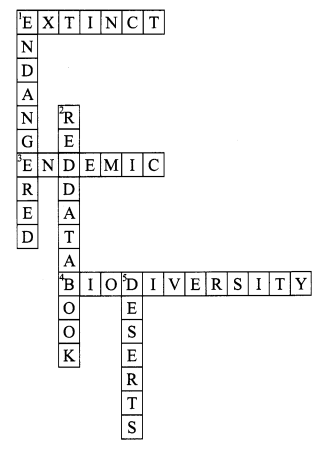Solutions For All Chapters Science Class 8
Question 1.
Fill in the blanks.
(a) A place where animals are protected in their natural habitat is called ______
(b) Species found only in a particular area is known as ______
(c) Migratory birds fly to faraway places because of ________ changes.
Answer:
(a) Wildlife sanctuary
(b) endemic species
(c) climatic
Question 2.
Differentiate between the following.
(a) Wildlife sanctuary and biosphere reserve
| Wildlife sanctuary | Biosphere reserve |
| The area reserved in a forest for the protection of wild animals. | The area meant for the protection or conservation of the biodiversity. It also helps in maintaining the culture of that area. |
(b) Zoo and wildlife sanctuary
| Zoo | Wildlife sanctuary |
| A place where animals are protected in an artificial habitat, for an exhibition. | A protected area where animals live in their natural habitat. |
(c) Endangered and Extinct species
| Endangered species | Extinct species |
| The species of animals whose numbers are diminishing to such a level that they might face extinction. | The species of animals whose number is zero because of changes in their habitat and other calamities. |
(d) Flora and Fauna
| Flora | Fauna |
| The plants which are found in a particular area; e.g.Jamun, sal, etc. | The animals which are found in a particular area; e.g., leopard, cheetah, elephant, etc. |
Question 3.
Discuss the effects of deforestation on the following:
(a) Wild animals
(b) Environment
(c) Villages (Rural areas)
(d) Cities (Urban areas)
(e) Earth
(f) The next generation
Answer:
(a) Wild animals: Trees are the habitats as well as sources of food for the wild animals. Deforestation leads to the destruction of the natural habitats of wild animals.
(b) Environment: Deforestation increases the temperature and pollution level of the environment. With the increase in the carbon dioxide level and a decrease in the oxygen level, it gives rise to global warming. It also lowers the level of ground water. Moreover, deforestation decreases the soil fertility and so, increases the chances of natural calamities.
(c) Villages (Rural areas): The decline in rainfall, the decrease in soil fertility, and the chances of natural disaster affect the village life.
(d) Cities (Urban areas): Deforestation result in global warming. It also results in the increase in the level of pollution. Hence, deforestation affects the life in cities.
(e) Earth: Deforestation decreases the fertility of soil. It changes the physical properties of soil. All these changes result in desertification.
(f) The next generation: Deforestation will majorly affect the life of next generation. The next generation will face problems at every step. Climatic conditions will be adversely affected. There will be scarcity of food and clean environment. Next generation won’t be able to see most of the animal species due to habitat loss.
Question 4.
What will happen if
1. we go on cutting trees
2. the habitat of an animal is disturbed.
3. the top layer of soil is exposed.
Answer:
1. If we go on cutting trees, then:
a) the temperature will increase to a greater extent.
b) the chances of natural disaster to occur will increase.
c) the water cycle will get disturbed.
2. If the habitat of an animal is disturbed, then:
a)the animals will lose their natural habitat and will reach the level of being endangered.
b)most of the animals may be forced to invade places meant for human living in search of food and shelter.
3. If the top layer of soil is exposed, then:
a)the exposed layer will lose all its nutrients, especially the hummus.
b)the water holding capacity of soil will decrease.
c)desertification will take place.
Question 5.
Answer in brief.
1. Why should we conserve biodiversity?
2. Protected forests are also not completely safe for wild animals. Why?
3. Some tribals depend on the jungle. How?
4. What are the causes and consequences of deforestation?
5. What is Red Data Book?
6. What do you understand by the term migration?
Answer:
1. The variety in life existing on the earth, their inter-relationships, and their relationships with the environment is referred to as biodiversity. We should conserve biodiversity so as to maintain the food chain. The disturbance in the food chain may affect the whole ecosystem.
2. Since capturing and killing of animals by poachers is still rampant in protected forests and areas, so they are not safe for wild animals.
3. Some tribes depend on the jungle for the fulfillment of their basic needs of life, such as food, medicine, clothing, shelter, etc.
4. The causes of deforestation may be the following:
a) Natural causes like forest fires, droughts, etc.
b) Building factories and houses.
c) Procuring land for cultivation.
d) Making furniture and using wood as fuel.
The consequences of deforestation are:
e) Natural calamities like floods, etc.
f) Increase in the temperature of the earth, i.e., global warming.
g) Change in the physical properties of soil.
h) A decrease in groundwater level.
i) Extinction of many flora and fauna.
5. Red Data Book is a sourcebook which keeps records of all endangered plants and animals.
6. Migration means the movement of a species from its own habitat to some other place during a certain period in a year for breeding or to overcome some climatic conditions.
Question 6.
In order to meet the ever-increasing demand in factories and for shelter, trees are being continually cut. Is it justified to cut trees for such projects? Discuss and prepare a brief report.
Answer:
It’s not justified to cut trees just to fulfill our needs. Trees are known as ‘the lung of the earth’. They are the habitat of many living organisms, including animals. They give us oxygen, and maintain the O2-CO2 balance as well. They firmly bind the soil and hence prevent soil erosion. They also reduce the chances of natural disasters like floods and droughts. They help conserve our rich biodiversity. The cutting of trees causes an increase in the carbon dioxide (CO2) level, which results in global warming. Moreover, it causes soil erosion, floods, the greenhouse effect, etc. Hence, trees must be protected.
Question 7.
How can you contribute to the maintenance of green wealth of your locality? Make a list of actions to be taken by you.
Answer:
By taking up the following actions, I can contribute to the maintenance of green wealth of my locality by:
1. Planting saplings and trees.
2. Not throwing the garbage on the streets.
3. Forbidding others to cut trees.
4. Making people aware of the significance of a clean and green environment.
5. Watering the plants regularly and taking proper care of them.
6. Reusing and recycling paper to save trees, energy, and water.
Question 8.
Explain how deforestation leads to reduced rainfall.
Answer:
Trees give out a huge amount of water in the form of water vapour during transpiration. The reduction of water vapour affects cloud formation and thus, results in less rainfall.
Question 9.
Find out about national parks in your state. Identify and show their location on the outline map of India
Answer:
Consider the map given below:
Question 10.
Why should paper be saved? Prepare a list of ways by which you can save paper.
Answer:
A large number of trees can be saved by saving paper. This will also save water that is used to manufacture paper. Moreover, the harmful chemicals used in papermaking will show their least effects on human beings and other organisms.
Some ways to save paper are the following:
1. recycling of paper.
2. economical use of paper.
3. paper should not be burnt.
Question 11.
Complete the word puzzle.
Down
1. Species on the verge of extinction.
2. A book carrying information about endangered species.
5. Consequence of deforestation.
Across
1. Species which have vanished.
3. Species found only in a particular habitat.
4. Variety of plants, animals and microorganisms found in an area.
Solution:



Leave a Reply